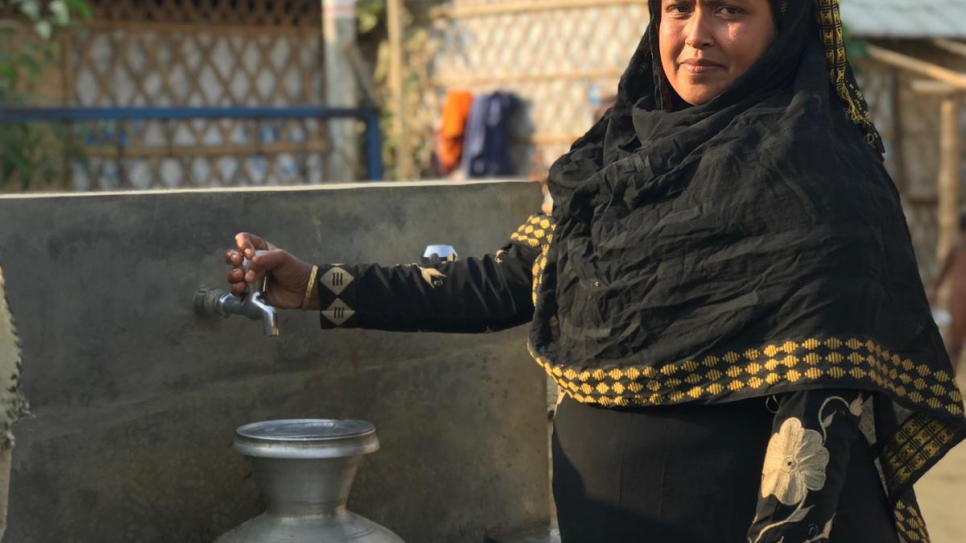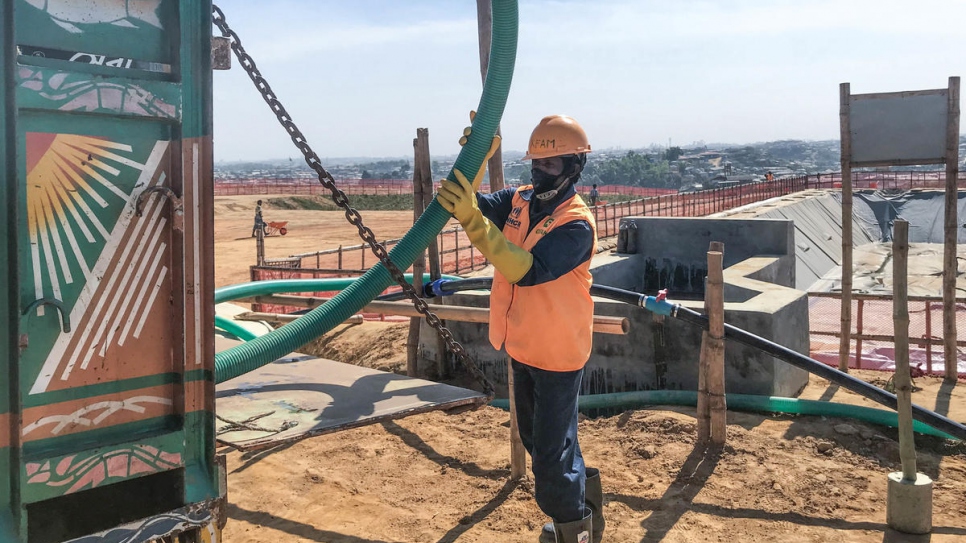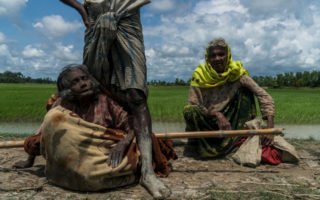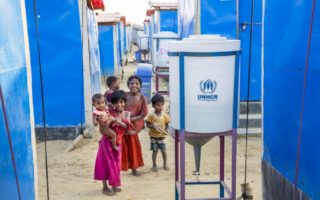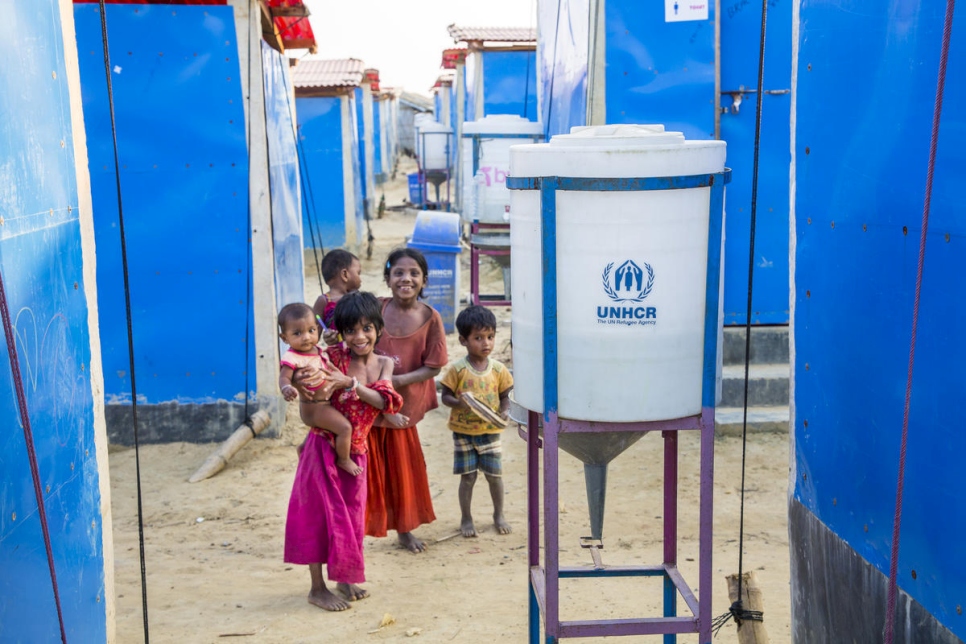
Rohingya children play at Kutupalong refugee settlement in Bangladesh. © UNHCR/Roger Arnold
UNHCR and its partners are using solar power to help provide safe, clean water to thousands of Rohingya refugees in Bangladesh.
By Caroline Gluck and Iffath Yeasmine in Kutupalong refugee site, Bangladesh.
For months after fleeing violence in Myanmar, Rohingya refugee Nurul Salam and his wife Lalu Begum drew water from a hand pump that frequently left their family with sore throats and diarrhoea.
“The water point was near a drain. We never knew if it was pure water or not. The area was really dirty and we got sick very often,” says Nurul, 35.
Now, thanks to a recently installed solar-powered water system, they are among thousands of people in the crowded Kutupalong refugee settlement in Cox’s Bazar who can walk to a stand, turn on a tap and fill a jug with potable water.
With access to a deep well and a system that chlorinates the water, the couple and their neighbours in the settlement have fewer health issues.
“My wife … had diarrhoea and sometimes she had fever. Now, things are very different. She hasn’t been sick in the last few months,” says Nurul, who also relies on clean water for the tea stall he runs at the sprawling settlement.
“The water point was near a drain … The area was really dirty and we got sick very often.”
The couple are among some 745,000 refugees who fled to Bangladesh after a government crackdown in August 2017 drove them from their homes in Myanmar’s northern Rakhine State.
The family originally settled in a waterlogged section of the settlement, but were relocated to a new extension area where they are among 3,500 children, women and men benefitting from clean water.
“Where we lived before, if there was a heavy storm, the drain water levels rose and entered our shelter,” Nurul recalls. “Water was a curse then. Now, water is a blessing. The children aren’t sick anymore.”
Three out of 10 people worldwide do not have access to potable water – according to the UN World Water Development Report 2019, Leaving no one behind – despite safe drinking water and sanitation being recognized as basic human rights, indispensable to health and human dignity.
The solar-powered water system is one of eight new networks jointly completed by UNHCR, the UN Refugee Agency, OXFAM, Médecins Sans Frontières and Bangladeshi non-governmental agency BRAC, which have been installed in the last half year, supplying a total of 40,000 people across the site. There are plans to install another 10 networks in the coming year, which will benefit 80,000 more refugees.
The systems run entirely on electricity generated through solar panels. Motorized pumps draw water from deep boreholes to newly-installed 70,000-litre tanks where chlorine kills bacteria and other harmful microbes. It is then piped to collective water points strategically installed throughout the Kutupalong-Balukhali site.
“It’s much less difficult, more convenient than before,” says Lalu, who also helps as a hygiene volunteer with UNHCR’s partner BRAC, as she collects water at the taps. “We used to have long queues and devote a lot of energy towards getting water (but now) I can get all the water on my own.”
Among refugees benefitting from the new supply is hygiene volunteer Mohammed Baser, 20, and his wife and baby daughter Shomima.
“We also used to live in an area where rubbish gathered. The smell was really bad. My daughter used to get sick all the time: she had fever, diarrhoea and throat infections. The water smelled and the surroundings were not good.
“The water here is good …. Before, we didn’t realise we were getting sick because of the water.”
More than 900,000 Rohingya refugees are living across 34 different locations in Cox’s Bazar, Bangladesh.
Efforts to provide enough safe drinking water for refugees across all the heavily congested sites has presented a massive challenge for humanitarian agencies, requiring the drilling of deep tube wells, building water networks including the installation of pipes, dams, canals, filtering mechanisms and chlorination systems.
Additionally, UNHCR and Oxfam earlier this year put into service the biggest human waste treatment facility ever built in a refugee settlement. The plant is able to process the waste of 150,000 people.
“Chlorinating water helps in maintaining safe water and eliminates any risk of spread of disease.”
In most locations, water is scarce. In the dry season, especially in areas like Nayapara, often the only solution is water trucking, which is very costly. It has been challenging to secure adequate water sources for the whole refugee population. In response, UNHCR and partners, working closely with the Government of Bangladesh, have stepped up their efforts in the past year to look at lasting solutions for water and sanitation.
“The new solar powered water networks reduce energy costs and fuel emissions,” says Murray Wilson, head of UNHCR’s water, sanitation and hygiene (WASH) programmes in Cox’s Bazar.
UNHCR and its partners aim to provide 20 litres of chlorinated water per day to every individual refugee – ensuring safe water for all.
“Chlorinating water helps in maintaining safe water and eliminates any risk of spread of disease,” Wilson says. “Previous water sources, mainly boreholes fitted with hand pumps were often highly contaminated by waste water penetrating the aquifer from which the wells drew water.”
“This is a fundamental step-change in the way we approach delivering services for refugees.”
Originally published by UNHCR on 21, March 2019



